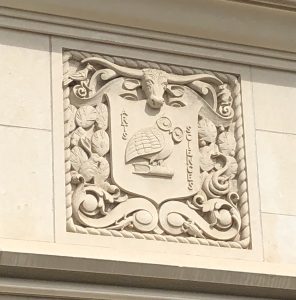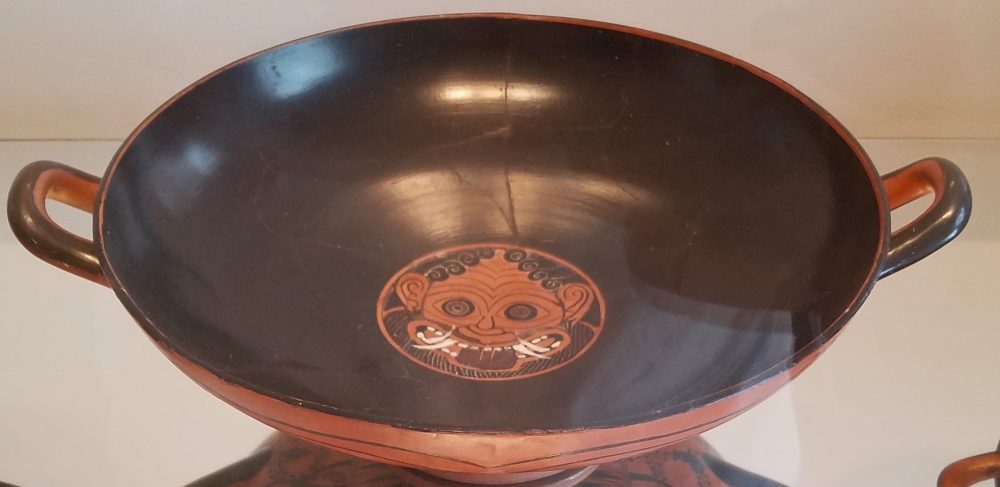 I. Architect: The Union building at the University of Texas was designed and completed by Robert L. White and Paul Cret. Paul Cret was an architect from Lyon, France that dedicated his work to design many famous public buildings across the United States. In nineteen thirty, Paul Crete was hired by the University of Texas as a consulting architect for a construction plan at the University, including the construction of the Union building, and continued to work at the University until his death fifteen years later. Some of his most notable works at the University of Texas include the Library on campus, the Architecture building, the Union building, the Home Economics building, the Littlefield memorial, the Yount House, the Texas Memorial Museum, and many dormitories on campus. Comparatively, Robert L. White was an architect from in Cooper, Texas. In nineteen twenty-one, White finished his bachelor’s degree in architecture at the University of Texas, and then came back to the University of Texas nine years later to obtain his master’s degree in architecture. While White was at the University of Texas attending graduate school for architecture, he became the supervising architect at the University of Texas. During this time, White was able to plan and execute many of the large building projects at the University of Texas during that were completed during the nineteen thirties, until his resignation twenty-eight years later. Some of his most famous constructions on campus include the Main Building, Goldsmith Hall, the Texas Union, and the Hogg Auditorium. Both Paul Crete and Robert L. White were important figures in the construction of the Union building and in the construction of many other important buildings on campus at the University of Texas.
I. Architect: The Union building at the University of Texas was designed and completed by Robert L. White and Paul Cret. Paul Cret was an architect from Lyon, France that dedicated his work to design many famous public buildings across the United States. In nineteen thirty, Paul Crete was hired by the University of Texas as a consulting architect for a construction plan at the University, including the construction of the Union building, and continued to work at the University until his death fifteen years later. Some of his most notable works at the University of Texas include the Library on campus, the Architecture building, the Union building, the Home Economics building, the Littlefield memorial, the Yount House, the Texas Memorial Museum, and many dormitories on campus. Comparatively, Robert L. White was an architect from in Cooper, Texas. In nineteen twenty-one, White finished his bachelor’s degree in architecture at the University of Texas, and then came back to the University of Texas nine years later to obtain his master’s degree in architecture. While White was at the University of Texas attending graduate school for architecture, he became the supervising architect at the University of Texas. During this time, White was able to plan and execute many of the large building projects at the University of Texas during that were completed during the nineteen thirties, until his resignation twenty-eight years later. Some of his most famous constructions on campus include the Main Building, Goldsmith Hall, the Texas Union, and the Hogg Auditorium. Both Paul Crete and Robert L. White were important figures in the construction of the Union building and in the construction of many other important buildings on campus at the University of Texas.
II. Date: The building of the Union building along with the image of the Owl of Athena was started in nineteen thirty-two and completed in 1933 by the architects Paul Phillipe Cret and Robert L. White.
III. Location: The image of the Owl of Athena is presented on the front of the Union building at the University of Texas above the word “Commons,” and can be viewed when standing and looking at the Union building from the West Mall area on campus. The Union building itself is located at the corner of Guadalupe and twenty-second street in the West Mall area of the University of Texas.
IV. Reason for Placement: The Union building was created to be a sort of “home away from home” for UT students by providing them with a place to relax and hang out with their friend and classmates. The Union building was also designed to be a place where students could enjoy meals together, and even have fun events like dances. The revenue obtained by funds from Texas and the University of Texas allowed the ideas of Crete and White to come alive. The construction of the Union building started nineteen thirty-two, and was completed just a year later in nineteen thirty-three. The construction of the Union building also included many decorative symbols that represent the University and Texas as a whole, and within these symbols lay the Owl of Athena which was added to represent the wisdom that is represented through the Greek goddess, Athena.
V. Description: The owl of Athena on the Union building is a stone sculpture embedded in the external wall of the Union building. The owl of Athena on the building is made from smooth limestone and rubble, which is the same material that was used to construct the Union building. The graphic of the Owl of Athena and the decorative symbols around it are in a square formation, with the owl of Athena situated below a Texas longhorn, and surrounded by other symbols representing Texas. The entire image is approximately two by two feet and is situated above the word “Commons” on the Union building.
In Greek myth, the goddess Athena is known as the goddess of wisdom, war, heroism, and crafts. Athena was conceived by Zeus, the god of the sky and thunder, and Metis, the goddess of wisdom and deep thought, but Athena’s birth was quite unusual. In order to prevent Metis from having a child that would be a threat to his power, Zeus swallowed Metis while she was pregnant with Athena. But this did not stop her birth, and Athena was instead born from the head of Zeus fully armored and ready for war. This detail relays the idea that Athena has the same intelligence and wisdom of the supreme ruler Zeus, making her a stronger goddess in myth. Athena is also closely associated with strategic skill in warfare and is commonly depicted next to heroes in myth who then typically become victorious when in her presence. The image of the owl is strongly associated with Athena which dates back to Athena and her role as a goddess in early Greek myth. In fact, one of Athena’s ancient epithets is Glaukopis, which symbolizes her role as a bright-eyed Owl Goddess. The name Glaukopis comes from the Greek word glaux, which means little owl. In myth, these under ten inch owls were sacred to Athena and therefore account for the origins of her owl-eyed Glaukopis epithet. Some historians accounted for this association by describing a species of owl that had a strong presence in Athens during the era of ancient Greece. Being that Athena is the patron goddess of Athens, the owl species in Athens quickly and easily became a symbol for Athena herself. In Greek myth, the owl of Athena is also said to be kept on the shoulder of Athena and reveal truths of the world to her, and thus also represent the literal wisdom and knowledge of Athena in her role as a goddess of wisdom. Additionally, this association meant that even the mere sight of an owl before a battle in myth made Greek soldiers believe that Athena was blessing them for a victory in battle. The Owl of Athena displayed on the Union building at the University of Texas symbolizes that University of Texas values wisdom and the pursuit of it on campus. As mentioned before, the owl of Athena is a symbol associated with the tangible wisdom that is represented through the Greek goddess Athena. When viewing the image of the Owl of Athena on the Union building, one can see that the Owl of Athena is situated between the words “Arts” and “Sciences” revealing that obtaining wisdom in the arts and sciences is a priority at the University of Texas. Another aspect of the image of the Owl of Athena shows the owl sitting atop a pile of books, which is said to represent education at the University of Texas and the pursuit of knowledge through the education that the University provides. Additionally, the image of the Owl of Athena depicted on the Union building is accompanied by many images and symbols that represent the University of Texas and Texas as a state. These symbols around the Owl of Athena include a Jackrabbit, Rattlesnake, Roadrunner, Horned Toad, Cacti, and the mascot at the University of Texas, the Longhorn. Displaying these modern images and symbols of Texas along with the ancient image of the Owl of Athena demonstrates how the University uses a Greek mythological image to portray a message and a purpose for the University. The symbols associated with Texas represent the University as a whole, and the Owl of Athena lies within these symbols, representing the wisdom associated with Athena as a goddess. Tying in the images of Texas and of ancient Greek myth with the image of Athena the central point, shows that the University values intelligence and wisdom above everything else. By adding this decorative collaboration to the Union building, modern audiences can recognize a relationship between the symbolism of ancient Greek images and modern Texas images, showing that the meaning of Athena as the goddess of wisdom is still recognizable and used in modern institutions even thousands of years later.
Bibliography
“Athena Glaukopis.” The Obscure Goddess Online Dictionary. Accessed April 30, 2019. http://www.thaliatook.com/OGOD/glaukopis.html
“Athena: Greek Goddess of Wisdom and War.” Accessed April 24, 2019. https://greekgodsandgoddesses.net/goddesses/athena/
Buxton, Richard. “The Olympians: Power, Honour, Sexuality.” In The Complete World of Greek Mythology, 80. Thames & Hudson Ltd, 2004.
Cret, Paul Philippe. “An Inventory of his Drawings, Photographic Material, and Papers, 1930-1957.” Texas Archival Resources Online. Accessed April 20, 2019.
https://legacy.lib.utexas.edu/taro/utaaa/00016/aaa-00016.html
Hesiod. “Hesiod’s Theogony.” In Anthology of Classical Myth, edited by Stephen M. Trzaskoma, 156-157. Hackett Publishing Company, Inc., 2016.
Homer. “Homeric Hymn to Athena.” In Anthology of Classical Myth, edited by Stephen M. Trzaskoma, 204-205. Hackett Publishing Company, Inc., 2016.
Margaret C. Berry. Brick by Golden Brick: a History of Campus Buildings at the University of Texas at Austin.LBCo, 1993.
Todd A. Curtis. Classical Mythology in the Visual and Performing Arts: Classical Mythology on UT’s Campus. Top Hat, January 2018. https://app.tophat.com/e/989965/assigned/
“What Does the Owl of Athena Represent?” Reference. Accessed April 23, 2019. https://www.reference.com/?qo=undefined
White, Robert Leon. “An Inventory of Drawings and Papers, 1882-1998, undated.”Texas Archival Resources Online. Accessed April 20, 2019. https://legacy.lib.utexas.edu/taro/utaaa/00011/aaa-00011.html
Written by Sophia Eggenberger

Very interesting blog entry. One correction – the architect’s name is Paul Cret not Crete.
Thank you for pointing this out.